This article explains how to move the audit table from the default tablespace to a user-created tablespace with Oracle Database 11g and 12c.
Plan:
- Intorduction:
- Move audit table on Oracle database 11g:
- Move audit table on Oracle database 12c:
- conclusion
1. Introduction:
Database auditing helps meet your database security and compliance requirements. Audit records are written to database tables, operating system (OS) files, or XML files depending on the AUDIT_TRAIL initialization parameter setting, for more information with Oracle database 11g and Oracle database 12c.
2. Move audit table to user-created tablespace on Oracle database 11g:
After the administrator has enabled database auditing (with the AUDIT_TRAIL parameter) and specified auditing options, the database begins collecting audit information
The parameter values can be:
- NONE: Disables collection of audit records
- DB: Enables auditing with records stored in the database
- DB,EXTENDED: Populates SQLBIND and SQLTEXT columns
- XML: Enables auditing with records stored in XML format OS files
- XML,EXTENDED: Includes SQLBIND and SQLTEXT information
- OS: Enables auditing with records stored in the OS audit trail
While the AUDIT_TRAIL parameter equal to DB or DB,EXTENDED then all audit are recorded on the table SYS.AUD$ and the Faine Grained Audit are recorded on the table SYS.FGA_LOG$ on the tablespace SYSTEM.
To minimize the effect on performance in the SYSTEM tablespace, we can move the databaseaudit trail tables (SYS.AUD$ and SYS.FGA_LOG$) from the SYSTEM tablespace to a user-created tablespace by using the DBMS_AUDIT_MGMT.SET_AUDIT_TRAIL_LOCATION procedure.
a. Check the Size of AUD$ table:
SQL> select SEGMENT_NAME,TABLESPACE_NAME,BLOCKS,BYTES/1024/1024 "Size Mb" from dba_segments where SEGMENT_NAME = 'AUD$';
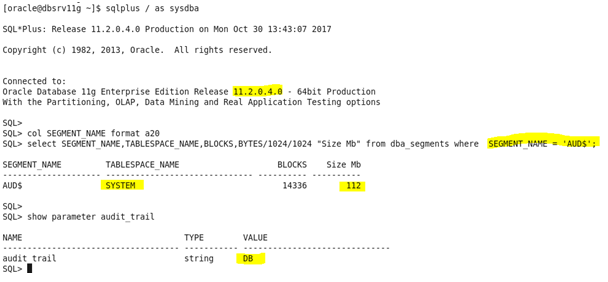
b. Creation of a tablespace to be the future audit tables tablespace destination:
Creation of a tablespace TBS_AUDIT:
![]()
c. Move SYS.AUD$ table t the tablepsace TBS_AUDIT:
SQL> exec DBMS_AUDIT_MGMT.SET_AUDIT_TRAIL_LOCATION(AUDIT_TRAIL_TYPE=>DBMS_AUDIT_MGMT.AUDIT_TRAIL_AUD_STD,AUDIT_TRAIL_LOCATION_VALUE => 'TBS_AUDIT') ;

d. Check the NEW location of AUD$ table:

Note: The DBMS_AUDIT_MGMT.SET_AUDIT_TRAIL_LOCATION procedure has the following parameters:
-
AUDIT_TRAIL_TYPE: Specifies the database audit trail type. Valid values are:
– DBMS_AUDIT_MGMT.AUDIT_TRAIL_AUD_STD: Indicates the standard audit trail table (SYS.AUD$)
– DBMS_AUDIT_MGMT.AUDIT_TRAIL_FGA_STD: Indicates the fine-grained audit trail table (SYS.FGA_LOG$)
– DBMS_AUDIT_MGMT.AUDIT_TRAIL_DB_STD: Indicates the standard and finegrained audit trail tables
-
AUDIT_TRAIL_LOCATION_VALUE: Specifies the destination tablespace
Note: Before executing the DBMS_AUDIT_MGMT.SET_AUDIT_TRAIL_LOCATION procedure, you should ensure that the destination tablespace has adequate space to accommodate the audit trail tables.
3. Move audit tables on Oracle database 12c:
a. Check if the Unified audit trail is activated or not:
SQL> SELECT value FROM v$option WHERE parameter = 'Unified Auditing'; VALUE ---------------------------------------------------------------- TRUE
b.Check the location of the Objects segments of the SCHEMA AUDSYS:
All Oracle Unified audit Trail are stored on the schema AUDSYS on the tablespace SYSAUX.
SQL> select SEGMENT_NAME,SEGMENT_SUBTYPE,SEGMENT_TYPE,BYTES/1024/1024,TABLESPACE_NAME from dba_segments where OWNER = 'AUDSYS';
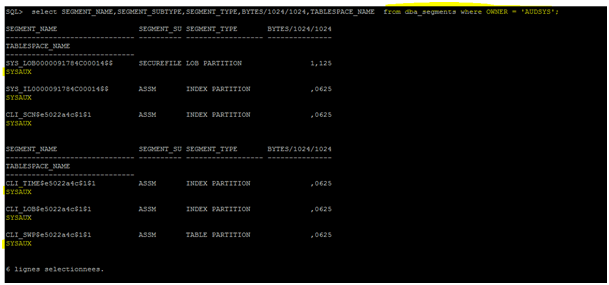
c. Creation of a policy to audit any action on HR.EMPLOYEES (to check the size of AUDSYS objects)
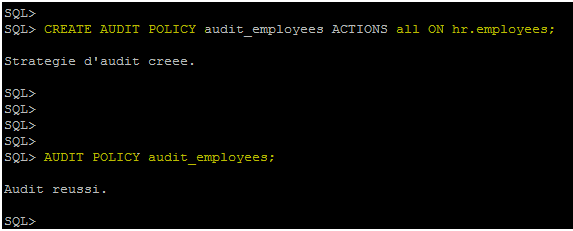
d. Move SYS.AUD$ table to the tablepsace TBS_AUDIT12c (with user SYS):
SQL> exec DBMS_AUDIT_MGMT.SET_AUDIT_TRAIL_LOCATION(AUDIT_TRAIL_TYPE=>DBMS_AUDIT_MGMT.AUDIT_TRAIL_UNIFIED,AUDIT_TRAIL_LOCATION_VALUE => 'TBS_AUDIT12c');
![]()
e. Check the new Location:
After the move to the new tablespace, we can get a duplicate row with the same segments name but with the new tablespace.
SQL> select SEGMENT_NAME,SEGMENT_SUBTYPE,SEGMENT_TYPE,BYTES/1024/1024,TABLESPACE_NAME from dba_segments where OWNER = 'AUDSYS' order by 1;
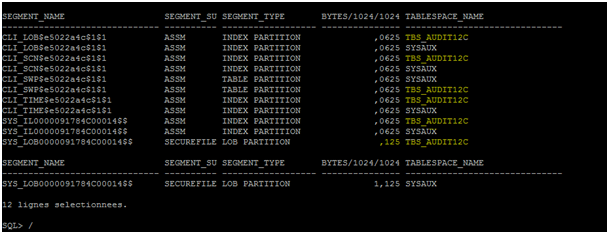
f. Create a Test of audit;
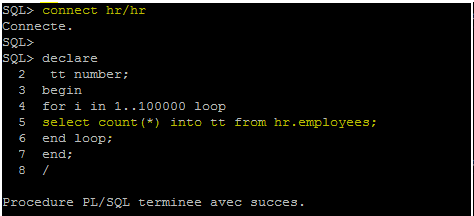
g. Purge the audit to the tables from memory (with SYS user):

h. Check the size again of the Objects:
SQL> select SEGMENT_NAME,SEGMENT_SUBTYPE,SEGMENT_TYPE,BYTES/1024/1024,TABLESPACE_NAME from dba_segments where OWNER = 'AUDSYS' order by 1;
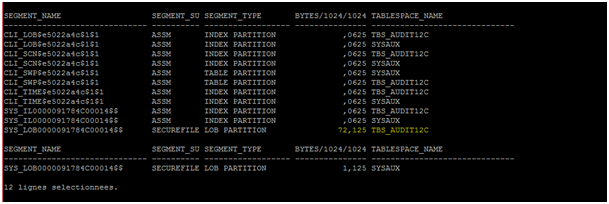
And again:

Note: The DBMS_AUDIT_MGMT.SET_AUDIT_TRAIL_LOCATION procedure has the following parameters:
-
AUDIT_TRAIL_TYPE: Specifies the database audit trail type. Valid values are:
– DBMS_AUDIT_MGMT. AUDIT_TRAIL_UNIFIED: Indicates the Audit trail unified 12c option
-
AUDIT_TRAIL_LOCATION_VALUE: Specifies the destination tablespace
Note: Before executing the DBMS_AUDIT_MGMT.SET_AUDIT_TRAIL_LOCATION procedure, you should ensure that the destination tablespace has adequate space to accommodate the audit trail tables.
4. Conclusion:
This article shows an example to move audit table from original tablespace to a user-created tablespace within Oracle database 11g and 12c.






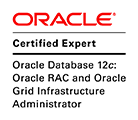






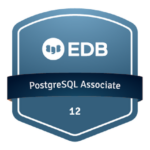
Pingback: php – how to solve ORACLE AUDSYS.SYS space error – Database Administrators Stack Exchange – ThrowExceptions